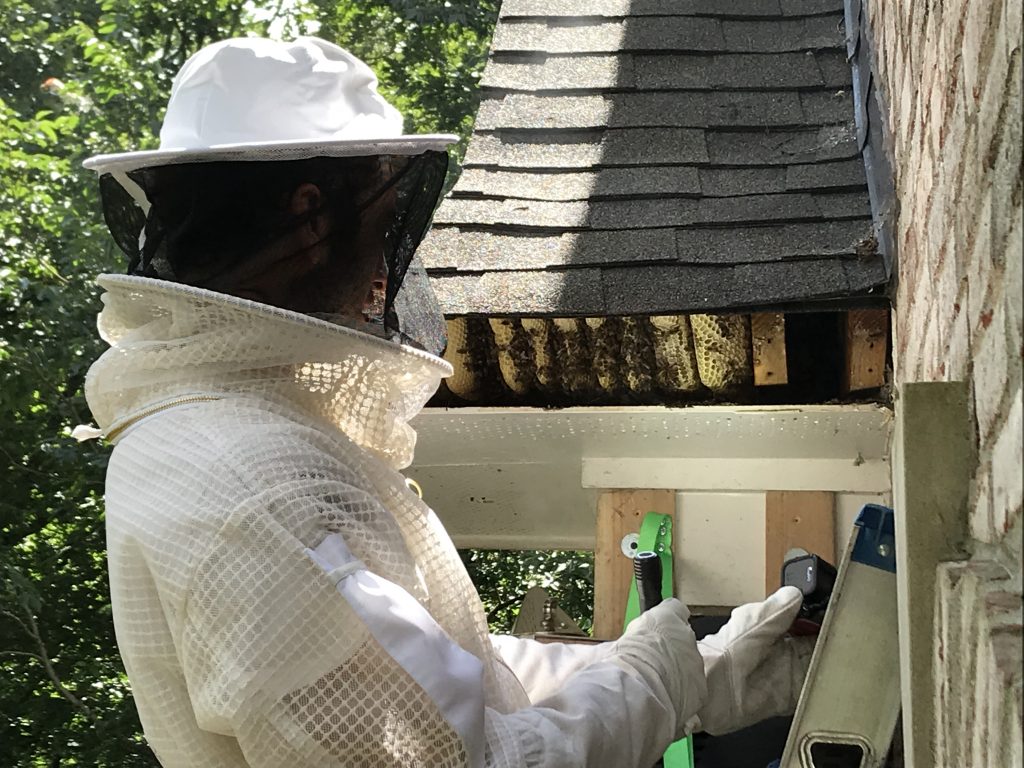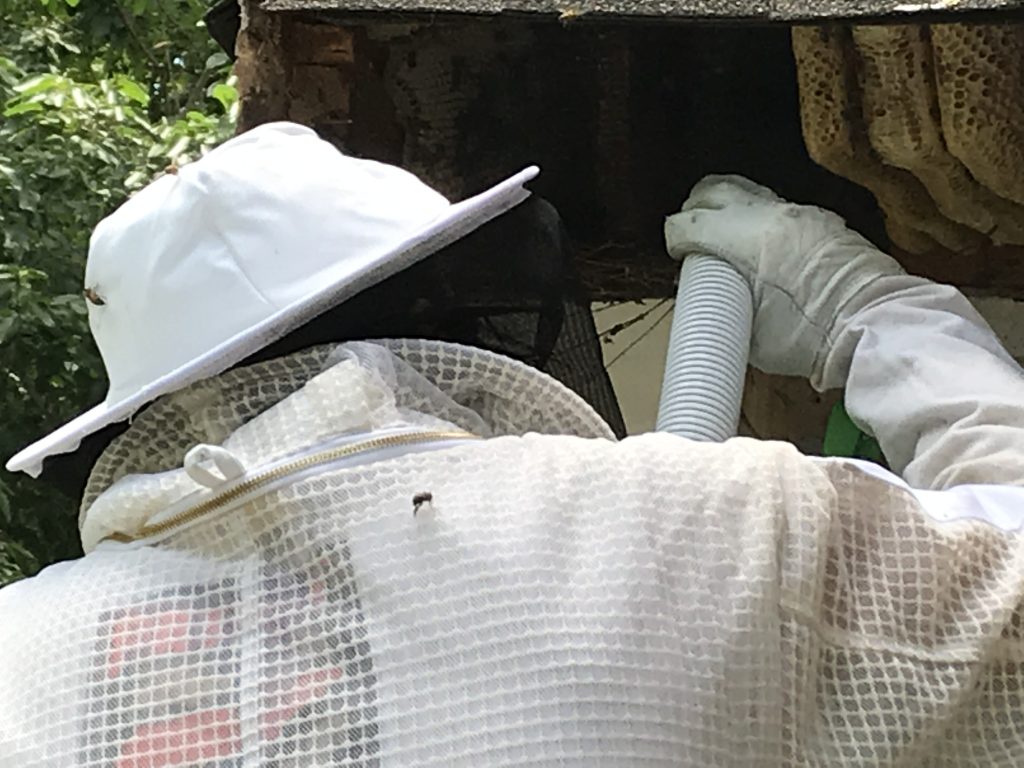Honey Bee Removal & Relocation
Honey Bees
[toc]
Honey bees are super-important pollinators for blossoms, fruits and vegetables. This suggests that they help other plants grow! Bees move pollen between flowers, which is how pollination occurs.
Honey bees live in hives (or colonies). The participants of the hive are separated into three sections:
Queen: One queen runs the entire hive. Her work is to lay the eggs that will certainly spawn the hive’s future generation of bees. The queen additionally produces chemicals that direct the behavior of the various other bees.
Workers: these are all females and also their duties are to forage for food (pollen and nectar from blossoms), build and protect the hive, clean, and flow air by beating their wings. Worker Bees are the only bees most people see flying around outside the hive.
Drones: These are the male bees, and their function is to mate with the brand-new queen. There are anywhere from several hundred to several thousand male drones during the spring and summer. Yet come wintertime, when the hive goes into survival setting, the drones are kicked out!
Honey Bee Removal From Structures
If possible, the honey bee colony should be saved alive, but this is not always possible. Swarms of honey bees that have recently entered a structure’s wall, say for a day or so, can often be exterminated by injecting a pesticide designed for bee control into the cavity. Unless there is a very strong nectar flow, the bees should not have had time to build a significant amount of comb, produce much brood, or store much honey. Keep in mind that if the bees have stored a lot of honey in the wall and you use a pesticide to kill the colony, the honey will be contaminated. Foraging bees from another nearby managed or feral bee colony will be drawn to the honey in the wall, resulting in the death of other colonies. Caulk or place window screening on all potential entrances to the wall cavity, such as knot holes and siding cracks, to avoid this problem. This will also prevent another swarm from entering the cavity the following swarm season. If the bees are not removed, a foul odor can definitely linger for several weeks in the area.
The job often becomes more difficult after the bees have established housekeeping for more than a few days. A structure’s wall can sometimes store a lot of comb (beeswax), brood, and honey. It’s dangerous to simply inject a pesticide into the wall to kill the bees and then leave. The comb will attract wax moths and mice looking for a place to nest. When the comb melts in hot weather, the honey will attract ants and other insects, and it may ooze through the wall or ceiling, causing extensive damage.

To get the job done right and avoid problems down the road, a process known as “neutralization” is required. To prevent future infestations, all bees (dead or alive), comb, and honey must be physically removed from the wall following extermination. When there are no humans or pets in the immediate area, the removal should be scheduled. To remove all odors from the previous colony, thoroughly wash the cavity with soapy water. If possible, leave the void area open for a few weeks to allow for drying and the dissipation of colony odors. The space will not be re-colonized if the void is filled with spray foam insulation or fiberglass batting before the wall is closed.
The neutralization process may have to be carried out inside the structure depending on the exterior wall construction, though in most cases, exterior wall removal is preferred. In the late evening, careful heat and noise observations can be used to determine the size of the bee colony’s wall space. When assessing the colony’s size, a stethoscope comes in handy. By listening for a significant reduction in the buzzing sound produced by the bees, an outline of the colony can be discerned. A light tap with a screw driver or hammer on the wall surface will increase the noise level.

The task of removing established bee colonies from structure walls can be made more pleasant by scheduling it at a time of year when bee populations are low, there is little stored honey, and the bees are less defensive. In South Carolina, the best time to remove bees is early spring, before the nectar flows begin. Late fall or a mild winter day are also good times to go.
Another method for removing bees from a structural wall is to cut out sections of the exterior wall and disrupt the colony during extremely cold temperatures. Honey bees are unable to fly in freezing temperatures and will usually perish as a result of their exposure. During cold temperatures, the neutralization process can be completed much more quickly. Even if bees can’t fly in the cold, they can crawl and sting.
As a result, when working in the cold, you should take the same precautions.
A honey bee (likewise spelled honeybee) is a eusocial flying insect within the category Apis of the bee clade. They are understood for construction of seasonal, early american nests from wax, for the plus size of their colonies, and also for their excess production as well as storage of honey, distinguishing their hives as a valued foraging target of numerous pets, including honey badgers, bears and also human hunter-gatherers. In the very early 21st century, only seven types of honey bee are recognized, with a total amount of 44 subspecies, though traditionally 7 to 11 varieties are acknowledged.
Bailey Prairie Texas Bee Removal
Bonney Texas Bee Removal
Brazoria Texas Bee Removal
Brookside Village Texas Bee Removal
Damon Texas Bee Removal
Danbury Texas Bee Removal
Freeport Texas Bee Removal
Hillcrest Texas Bee Removal
Holiday Lakes Texas Bee Removal
Iowa Colony Texas Bee Removal
Jones Creek Texas Bee Removal
Liverpool Texas Bee Removal
Manvel Texas Bee Removal
Oyster Creek Texas Bee Removal
Quintana Texas Bee Removal
Richwood Texas Bee Removal
Rosharon Texas Bee Removal
Sandy Point city Texas Bee Removal
Surfside Beach Texas Bee Removal
Sweeny Texas Bee Removal
West Columbia Texas Bee Removal
Wild Peach Village Texas Bee Removal
Arcola Texas Bee Removal
Beasley Texas Bee Removal
Cinco Ranch Texas Bee Removal
Cumings Texas Bee Removal
Fairchilds Texas Bee Removal
Fifth Street Texas Bee Removal
Four Corners Texas Bee Removal
Fresno Texas Bee Removal
Fulshear Texas Bee Removal
Greatwood Texas Bee Removal
Katy Texas Bee Removal
Kendleton Texas Bee Removal
Meadows Place Texas Bee Removal
Mission Bend Texas Bee Removal
Needville Texas Bee Removal
New Territory Texas Bee Removal
Orchard Texas Bee Removal
Pecan Grove Texas Bee Removal
Pleak Texas Bee Removal
Rosenberg Texas Bee Removal
Sienna Plantation Texas Bee Removal
Simonton Texas Bee Removal
Thompsons Texas Bee Removal
Weston Lakes Texas Bee Removal
Bacliff Texas Bee Removal
Bayou Vista Texas Bee Removal
Bolivar Peninsula Texas Bee Removal
Clear Lake Shores Texas Bee Removal
Dickinson Texas Bee Removal
Galveston Texas Bee Removal
Hitchcock Texas Bee Removal
Jamaica Beach Texas Bee Removal
Kemah Texas Bee Removal
La Marque Texas Bee Removal
San Leon Texas Bee Removal
Santa Fe Texas Bee Removal
Texas City Texas Bee Removal
Tiki Island Texas Bee Removal
Houston Texas Bee Removal
Pearland Texas Bee Removal
Seabrook Texas Bee Removal
Richmond Texas Bee Removal
Clear Lake Texas Bee Removal
Stafford Texas Bee Removal
Clute Texas Bee Removal
Friendswood Texas Bee Removal
Pasadena Texas Bee Removal
Missouri City Texas Bee Removal
Alvin Texas Bee Removal
Sugar Land Texas Bee Removal
Angleton Texas Bee Removal
Bellaire Texas Bee Removal
Lake Jackson Texas Bee Removal
League City Texas Bee Removal
The very best recognized honey bee is the western honey bee which has actually been tamed for honey manufacturing as well as plant pollination; modern humans also value the wax for candlemaking, soapmaking, lip balms, and also various other crafts. Honey bees stand for only a little fraction of the approximately 20,000 well-known species of bees. A few other types of associated bees generate as well as store honey and have been maintained by humans for that objective, including the stingless honey bees, yet only participants of the genus Apis are true honey bees. The research of bees, which includes the research study of honey bees, is called melittology.
Honey bees acquire all of their nutritional demands from a varied combination of plant pollen and also nectar. Plant pollen is the only natural protein resource for honey bees. Adult worker honey bees take in 3.4– 4.3 mg of plant pollen each day to fulfill a dry issue demand of 66– 74% healthy protein. The rearing of one larva needs 125-187.5 mg pollen or 25-37.5 mg protein for appropriate development. Nutritional healthy proteins are broken down into amino acids, 10 of which are considered essential to honey bees: methionine, tryptophan, arginine, lysine, histidine, phenylalanine, isoleucine, threonine, leucine, as well as valine.
Of these amino acids, honey bees need greatest focus of leucine, isoleucine, and also valine, nonetheless elevated focus of arginine as well as lysine are required for brood rearing. In addition to these amino acids, some B vitamins including biotin, folic acid, nicotinamide, riboflavin, thiamine, pantothenate, and most importantly, pyridoxine are required to rear larvae. Pyridoxine is the most common B vitamin located in imperial jelly and also concentrations differ throughout the foraging season with least expensive focus located in Might and highest possible concentrations located in July and August. Honey bees lacking dietary pyridoxine were not able to back brood.
Honey Bee Facts
1. Honey bees have a critical role in the pollination of flowers, fruits, and vegetables. This means that they promote the growth of other plants. Bees help plants produce seeds and fruit by moving pollen between the male and female reproductive organs.
2. Honey bees live in colonies or hives. Three groups make up the hive’s inhabitants:
Queen: A single queen oversees the entire hive. Her responsibility is to lay the eggs that will give rise to the hive’s newest colony of bees. The queen also makes chemicals that influence how the other bees behave.
Workers: They build and protect the hive, clean and move the air by beating their wings, and forage for food, which is pollen and nectar from flowers. Workers are entirely female. The only bees that most people ever see flying about outside the hive are workers.
Drones: These male bees’ only goal is to mate with the newly ascended queen. In the spring and summer, several hundred bees live each hive. But the drones are expelled in the winter when the hive shifts into survival mode!
3. For what are honey bees best known? Delectable honey! However, did you know that they produce honey to preserve food for the hive over the winter? Fortunately, these hardworking little creatures produce 2-3 workers more honey than they use, allowing us to partake as well.
4. If the queen bee dies, the worker bees will choose a young larva (the just formed baby insects) and feed it a special food called “royal jelly” to make a new queen. Due to this, the larva can grow into a reproductive queen.
5. Honey bees have amazing flight abilities. They beat their wings 200 times each second while they fly at a pace of about 25 km/h!
6. Bees have a keen sense of smell thanks to their 170 odorant receptors per bee. They utilize it to communicate among themselves and to distinguish between various kinds of flowers when foraging for food.
7. The lifespan of a worker bee is about five to six weeks on average. She will produce around a tenth of a teaspoon of honey throughout this period.
8. The queen has a five-year maximum lifespan. During the summer, when she may lay up to 2,500 eggs each day, she is most active.
9. Honey bees are also incredibly smart! They engage in their “waggle dance” in order to communicate information about the finest food sources. The worker waggles its body and moves in a figure-of-eight pattern when it enters the hive to point in the general direction of the food supply.
10. Sadly, bee colonies have been declining for the past 15 years, and the cause is still unknown. A condition known as “colony collapse disorder” is causing billions of honey bees to abandon their hives and never come back. Up to 90% of the bees in some areas have vanished!
